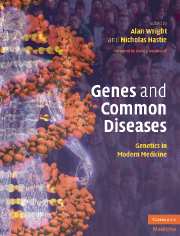Book contents
- Frontmatter
- Contents
- List of Contributors
- Foreword
- Section 1 Introductory Principles
- Section 2 Common Medical Disorders
- 13 Developmental disorders
- 14 Genes, environment and cancer
- 15 The polygenic basis of breast cancer
- 16 TP53: A master gene in normal and tumor suppression
- 17 Genetics of colorectal cancer
- 18 Genetics of autoimmune disease
- 19 Susceptibility to infectious diseases
- 20 Inflammatory bowel diseases
- 21 Genetic anemias
- 22 Genetics of chronic disease: obesity
- 23 Type 2 diabetes mellitus
- 24 Genetics of coronary heart disease
- 25 Genetics of hypertension
- 26 Obstructive pulmonary disease
- 27 Skeletal disorders
- 28 The genetics of common skin diseases
- 29 Molecular genetics of Alzheimer's disease and other adult-onset dementias
- 30 Major psychiatric disorders in adult life
- 31 Speech and language disorders
- 32 Common forms of visual handicap
- 33 Genetic and environmental influences on hearing impairment
- 34 Pharmacogenomics: clinical applications
- Index
- References
19 - Susceptibility to infectious diseases
Published online by Cambridge University Press: 17 August 2009
- Frontmatter
- Contents
- List of Contributors
- Foreword
- Section 1 Introductory Principles
- Section 2 Common Medical Disorders
- 13 Developmental disorders
- 14 Genes, environment and cancer
- 15 The polygenic basis of breast cancer
- 16 TP53: A master gene in normal and tumor suppression
- 17 Genetics of colorectal cancer
- 18 Genetics of autoimmune disease
- 19 Susceptibility to infectious diseases
- 20 Inflammatory bowel diseases
- 21 Genetic anemias
- 22 Genetics of chronic disease: obesity
- 23 Type 2 diabetes mellitus
- 24 Genetics of coronary heart disease
- 25 Genetics of hypertension
- 26 Obstructive pulmonary disease
- 27 Skeletal disorders
- 28 The genetics of common skin diseases
- 29 Molecular genetics of Alzheimer's disease and other adult-onset dementias
- 30 Major psychiatric disorders in adult life
- 31 Speech and language disorders
- 32 Common forms of visual handicap
- 33 Genetic and environmental influences on hearing impairment
- 34 Pharmacogenomics: clinical applications
- Index
- References
Summary
Introduction
The study of the host genetic component of infectious disease is potentially one of the most difficult areas of complex human genetic disease analysis for one major reason: the absolute requirement for a host–pathogen interaction to cause disease. Since the pathogen has its own genome, with all of its attendant potential for variability, there has been an ongoing “arms race” between man and microbe that has driven each to incorporate changes within their genomes that increase their survival chances should they encounter the other. However, this strong evolutionary pressure on the human genome has also inevitably produced associations between gene variants and disease. The field of genetic susceptibility to infectious disease has been around for over 50 years now and there is a substantial body of evidence for the role of genetics in infectious disease susceptibility.
Historical perspective
Infectious disease is as old as humanity and remains a significant influence on polymorphism in the human genome. Major effects of infectious disease such as epidemics that have drastically reduced populations to a small percentage of individuals, so-called “bottlenecks,” such as the Black Death in Europe and the introduction of smallpox and other diseases to the Americas, have a strong selective effect. In addition, the slow continual onslaught of endemic diseases that are still with us today, such as malaria, tuberculosis and, more recently, AIDS, lead to a continual enrichment within the population for resistance alleles, even when these might be harmful and would be quickly lost in the absence of disease.
- Type
- Chapter
- Information
- Genes and Common DiseasesGenetics in Modern Medicine, pp. 277 - 301Publisher: Cambridge University PressPrint publication year: 2007

